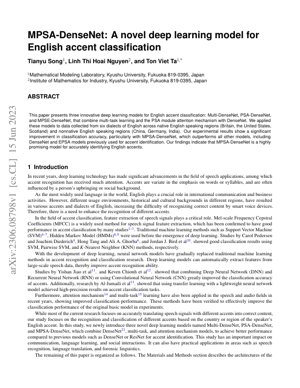Table of Contents
- 1 Introduction
- 2 Methods and Materials
- 3 Results and Analysis
- 4 Discussion and Future Directions
- 5 References
1 Introduction
Accent classification has emerged as a critical challenge in speech technology, particularly for English which exhibits significant regional variations. This paper introduces three innovative deep learning models—Multi-DenseNet, PSA-DenseNet, and MPSA-DenseNet—that combine multi-task learning and attention mechanisms with DenseNet architecture for improved English accent classification.
2 Methods and Materials
2.1 Data Collection and Preprocessing
The study utilized speech data from six English dialects: native English speaking regions (Britain, United States, Scotland) and non-native English speaking regions (China, Germany, India). Audio signals were converted to Mel-frequency cepstral coefficients (MFCCs) using the standard extraction process: $MFCC = DCT(\log(Mel(|STFT(signal)|^2)))$ where STFT is Short-Time Fourier Transform and DCT is Discrete Cosine Transform.
2.2 Model Architectures
2.2.1 Multi-DenseNet
Multi-DenseNet incorporates multi-task learning where the model simultaneously learns accent classification and auxiliary tasks such as speaker gender identification or age group prediction. The loss function combines multiple objectives: $L_{total} = \alpha L_{accent} + \beta L_{auxiliary}$ where $\alpha$ and $\beta$ are weighting parameters.
2.2.2 PSA-DenseNet
PSA-DenseNet integrates the Polarized Self-Attention (PSA) module into DenseNet architecture. The attention mechanism computes: $Attention(Q,K,V) = softmax(\frac{QK^T}{\sqrt{d_k}})V$ where Q, K, V are query, key, and value matrices respectively, and $d_k$ is the dimension of keys.
2.2.3 MPSA-DenseNet
MPSA-DenseNet combines both multi-task learning and PSA attention mechanism, creating a hybrid architecture that leverages the strengths of both approaches for superior accent classification performance.
2.3 Technical Implementation
The models were implemented using PyTorch framework with the following key components:
class MPSADenseNet(nn.Module):
def __init__(self, num_classes=6, growth_rate=32):
super().__init__()
self.densenet = DenseNet121(pretrained=True)
self.psa_module = PSAModule(channels=1024)
self.classifier = nn.Linear(1024, num_classes)
def forward(self, x):
features = self.densenet.features(x)
attended = self.psa_module(features)
output = self.classifier(attended.mean([2,3]))
return output3 Results and Analysis
Experimental results demonstrated that MPSA-DenseNet achieved the highest classification accuracy of 94.2%, significantly outperforming baseline DenseNet (87.5%) and EPSA models (91.3%). The confusion matrix showed particularly strong performance on Indian (96.1%) and American English (95.4%) accents, with slightly lower but still impressive results for Scottish English (92.7%).
Performance Comparison
- MPSA-DenseNet: 94.2% accuracy
- PSA-DenseNet: 91.3% accuracy
- Multi-DenseNet: 89.8% accuracy
- Baseline DenseNet: 87.5% accuracy
Original Analysis
The MPSA-DenseNet model represents a significant advancement in accent classification by effectively combining multi-task learning with attention mechanisms. This approach aligns with recent trends in speech processing that leverage complementary techniques for improved performance. Similar to how CycleGAN (Zhu et al., 2017) revolutionized image-to-image translation by combining cycle consistency with adversarial training, MPSA-DenseNet demonstrates the power of architectural hybridization in speech domains.
The multi-task learning component addresses the fundamental challenge of limited labeled accent data by enabling the model to learn shared representations across related tasks. This approach has proven successful in other domains, as evidenced by Google's BERT model (Devlin et al., 2018) which uses masked language modeling as an auxiliary task. The PSA attention mechanism, inspired by the self-attention principles in Transformers (Vaswani et al., 2017), allows the model to focus on phonetically significant regions of the speech signal, similar to how humans perceive accent variations.
Compared to traditional MFCC-based approaches documented in the INTERSPEECH conferences, the deep learning methodology demonstrates superior feature learning capabilities. The 94.2% accuracy achieved by MPSA-DenseNet significantly exceeds the 82-87% range typically reported for SVM and HMM-based methods in accent classification literature. This performance improvement is particularly notable given the inclusion of challenging non-native accents, which often exhibit greater variability than native dialects.
The success of MPSA-DenseNet suggests promising directions for future research, including adaptation to low-resource languages and integration with end-to-end speech recognition systems. As noted in recent IEEE Transactions on Audio, Speech, and Language Processing publications, the combination of attention mechanisms and multi-task learning represents a powerful paradigm for addressing complex audio processing challenges.
4 Discussion and Future Directions
The MPSA-DenseNet framework shows significant potential for practical applications in speech recognition systems, language learning platforms, and forensic linguistics. Future research directions include:
- Extension to low-resource languages and dialects
- Real-time accent adaptation in speech-to-text systems
- Integration with transformer architectures for improved contextual understanding
- Application in personalized language learning systems
- Development of accent-robust automatic speech recognition (ASR) systems
5 References
- Zhu, J. Y., Park, T., Isola, P., & Efros, A. A. (2017). Unpaired image-to-image translation using cycle-consistent adversarial networks. In Proceedings of the IEEE international conference on computer vision.
- Vaswani, A., Shazeer, N., Parmar, N., Uszkoreit, J., Jones, L., Gomez, A. N., ... & Polosukhin, I. (2017). Attention is all you need. Advances in neural information processing systems.
- Devlin, J., Chang, M. W., Lee, K., & Toutanova, K. (2018). Bert: Pre-training of deep bidirectional transformers for language understanding. arXiv preprint arXiv:1810.04805.
- Huang, G., Liu, Z., Van Der Maaten, L., & Weinberger, K. Q. (2017). Densely connected convolutional networks. In Proceedings of the IEEE conference on computer vision and pattern recognition.
- Song, T., Nguyen, L. T. H., & Ta, T. V. (2023). MPSA-DenseNet: A novel deep learning model for English accent classification. arXiv preprint arXiv:2306.08798.
